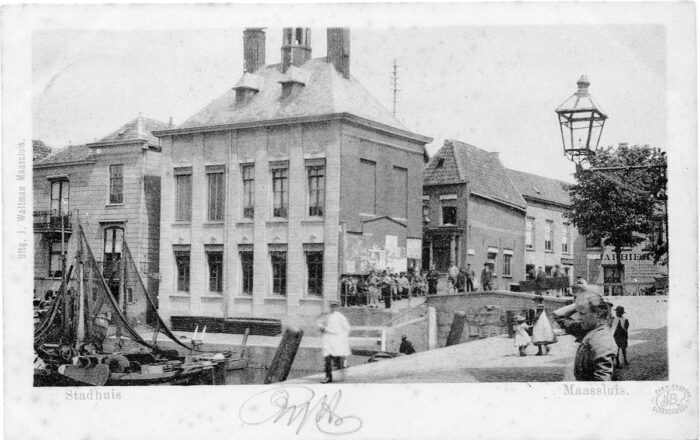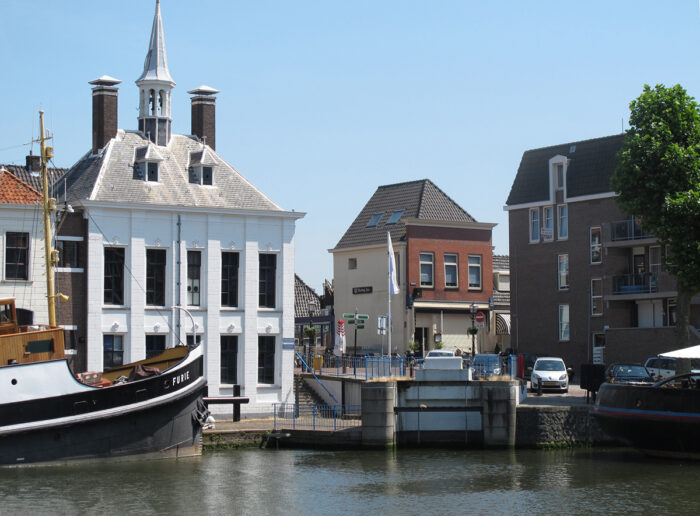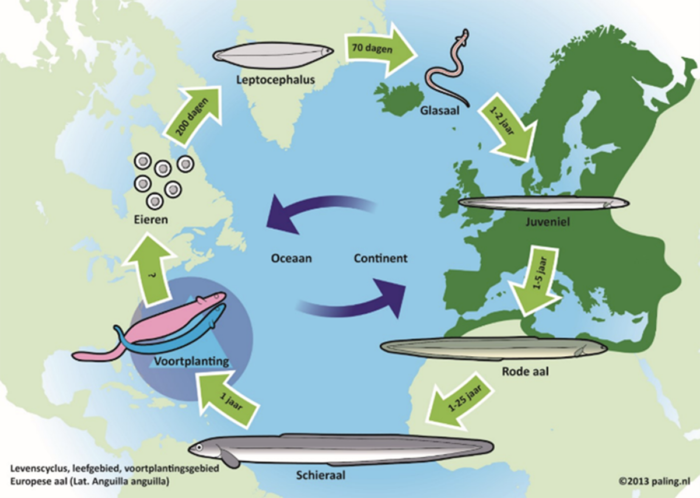
Wateringse sluis 1901
Wateringen sluice 1901

Verbouw in 1935
Renovation in 1935

Wateringse sluis 2015
Wateringen sluice 2015

Levensloop van de paling
Life course of the eel
In de 14e eeuw is een zeedijk aangelegd van de duinenrij bij ’s Gravenzande tot voorbij Rotterdam. Het zeewater dat de Maas inkomt kon vanaf toen niet langer de polders overstromen. Het regen- en grondwater uit de polder moest voortaan afgewaterd worden op de Maas. Daar moesten de gemeentes in de polder voor zorgen.
Het Hoogheemraadschap van Delfland, het waterschap in onze regio, wees Wateringen aan om de kosten te betalen van een afwateringskanaal naar de zeedijk met hier op deze plek een spuisluis die met schuiven kon worden geopend. De schuiven werden dagelijks opgetrokken als het water in de Maas laag stond (eb). Voor dat werk waren twee sluiswachters nodig, voor de Wateringse sluis en de Monsterse sluis hier vlakbij. De sluiswachters zagen dat er veel vis door de open sluizen zwom, vooral paling. Ze vingen en verkochten die. Rondom de sluizen ontstond de vissersplaats Maeslantsluys die in 1614 zelfstandig werd en sindsdien Maassluis heet.
In 1653 werd in opdracht van Wateringen de sluis met de schuiven vervangen door een stenen uitwateringssluis met deuren. In 1935 werd de tunnel van de sluis verlengd verder de Havenkom in.
Tot ongeveer 1985 is de Wateringse sluis een spuisluis gebleven. Toen kwam het moment dat spuien hier te duur werd door het dalen van de poldergrond en het stijgen van de zeespiegel. De deuren bleven dicht, voor het polderwater maar ook voor de palingen.
In 2022 heeft het Hoogheemraadschap van Delfland de Wateringse sluis toch weer in gebruik genomen als spuisluis. Niet voor het water, maar wel voor de vis! Door opnieuw water te gaan spuien kunnen vissen weer tegen de stroom in de polder binnen zwemmen, zoals paling en stekelbaarsjes. In de polder groeien ze tot ze volwassen zijn. Na een paar jaar trekken ze dan weer naar zee waar ze eitjes leggen. Uit de eitjes komen kleine visjes die weer naar de polders willen om daar te groeien.
Het Hoogheemraadschap van Delfland heeft een aantal aanpassingen gemaakt in de deuren om het spuien weer mogelijk te maken. Hierbij is de gehele sluis ook weer gerenoveerd. Tussen de haven en de sluiskolk zit een zware stalen schuif, in de sluiskolk zitten nog eens twee paar sluisdeuren. Hierin zijn kleine openingen gemaakt waarop automatische afsluiters zijn gemonteerd. Wanneer het water in de haven lager is dan in de boezem (aan de andere kant van de zeedijk) zullen de afsluiters een-voor-een open en dicht gaan zodat vissen vanuit de haven de sluis in kunnen zwemmen. De afsluiters gaan nooit gelijktijdig open. Zo wordt de stroomsnelheid niet te hoog voor de vissen en om het zoute water uit de haven kan niet de polder in. Met sensoren (voelers) wordt de waterhoogte in de haven voortdurend in de gaten gehouden. De sensoren doen automatisch de afsluiters open en dicht.
++++++++++++++++++++
THE WATERINGEN SLUICE
In the 14th century, a sea dike was built from the dunes near the sea at ’s Gravenzande to beyond Rotterdam. From then on, the seawater entering the river Meuse, nearby here, could no longer flood the polders. However, from then on, the rainwater and groundwater from the polder had to be drained into the Maas. The municipalities in the polder had to take care of that.
The regional Delfland Water Board appointed the municipality of Wateringen to pay the costs of a drainage canal to the sea dyke with a discharge sluice that could be opened with slides. The slides were raised daily when the water in the Meuse was low (ebb). Two sluice and lock keepers were needed for that work, for the Wateringen Sluice and the Monster Lock nearby. The lock keepers saw that a lot of fish were swimming through the open sluice and lock, especially eel. They caught and sold it. The fishing town of Maeslantsluys arose around lock and sluice. The town became an independent municipality in 1614 and has since been called Maassluis.
In 1653, Wateringen ordered the sluice with the slides to be replaced by a stone discharge sluice with doors. In 1935 the sluice was given an extended tunnel, further into the harbour basin.
Until about 1985, the Wateringen Sluice remained a discharge sluice. Then came the moment that discharging water here became too expensive due to the sinking of the polder land and the rising of the sea level. The doors remained closed, for the polder water but also for the eels.
In 2022 however, the Delfland Water Board put the Wateringen Sluice back into use as a discharge sluice. Not for the water, but for the fish! By discharging the water again, fish can swim back into the polder against the current, such as eels and sticklebacks. In the polder they grow until they are adult fish. After a few years they return to the sea where they lay eggs. Small fish hatch from the eggs and want in their turn to enter the polders to grow there.
The Delfland Water Control Board has made a number of adjustments to the doors to make flushing possible again. The entire sluice has also been renovated. There is a heavy steel gate between the harbour and the sluice chamber, and inside the chamber there are another two pairs of gates. Small openings have been made in these on which automatic shut-off valves are mounted. When the water in the harbour is lower than in the storage canal (on the other side of the sea dike), the valves will open and close one by one so that fish can swim from the harbour into the sluice. The valves never open simultaneously. This way the flow speed does not become too high for the fish and the salt water from the harbour cannot enter the polder. The water level in the port is constantly monitored with sensors. The sensors automatically open and close the valves.

Wateringse sluis 1901
Wateringen sluice 1901

Verbouw in 1935
Renovation in 1935

Wateringse sluis 2015
Wateringen sluice 2015

Levensloop van de paling
Life course of the eel